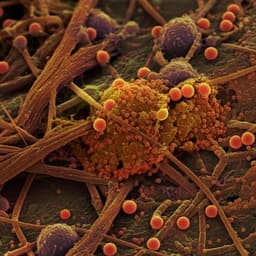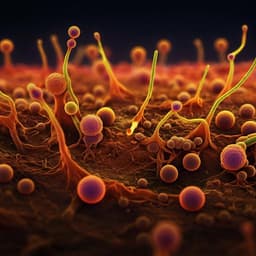
Environmental Studies and Forestry
Environmental and microbial controls on microbial necromass recycling, an important precursor for soil carbon stabilization
K. M. Buckeridge, K. E. Mason, et al.
This research, conducted by Kate M. Buckeridge and colleagues, reveals the intricate controls on microbial necromass recycling efficiency in UK grassland soils, shedding light on its impact on soil carbon stabilization amidst varying environmental conditions.
~3 min • Beginner • English
Introduction
Protecting and increasing soil carbon storage is a global challenge with implications for food security and climate mitigation. Traditional focus on plant input quantity and quality as controls on soil carbon storage has shifted to recognize that assimilation of plant carbon into microbial biomass is an important precursor to soil carbon stabilization. Microbial residues (necromass) arising from microbial death can be recycled by microbes for growth or stabilized on mineral surfaces and within aggregates. Given that necromass forms a large fraction (50–80%) of stable soil organic carbon, microbial processing of plant-derived carbon, the amount of necromass produced, and the recycling of necromass are key controls on soil carbon storage. The authors propose that necromass recycling efficiency is a critical, previously unassessed parameter influencing soil carbon storage. Land use intensity (LUI) is a major driver across grasslands and is associated with microbial processes influencing carbon turnover; it could select for different microbial strategies (r- vs. K-selected) affecting carbon use efficiency (CUE) and substrate use. The study hypothesizes that high LUI selects for fast-growing microbes using labile substrates leading to higher CUE, whereas low LUI favors microbes capable of recycling complex substrates like necromass. Environmental factors (soil properties, climate) are expected to interact with LUI to influence microbial community composition and necromass recycling. Aims: (1) quantify microbial necromass recycling efficiency across LUI; (2) characterize environmental and microbial controls on necromass recycling efficiency; (3) identify microbes associated with high necromass recycling efficiency. The study sampled 27 sites (three LUI levels at nine UK grassland farms spanning gradients of precipitation, temperature, pH, and soil C) and measured CUE on 13C-glucose and 13C-labeled Escherichia coli necromass, using stable isotope probing and sequencing to identify microbial guilds dominating substrate uptake and recycling.
Literature Review
Background literature indicates: (1) microbial necromass constitutes a major portion (50–80%) of stable soil organic carbon, highlighting the centrality of microbial processing to stabilization; (2) plant carbon routed through microbial biomass is a precursor to stable soil carbon, in line with frameworks such as the microbial efficiency-matrix stabilization (MEMS) concept; (3) land use intensification can increase soil carbon losses and alter microbial processes that promote turnover, potentially affecting microbial CUE; (4) soil microbial communities are strongly shaped by pH, climate, and management; (5) historical precipitation regimes can exert lasting controls on microbial carbon cycling responses to moisture. These lines of evidence motivate direct assessment of necromass recycling efficiency and its environmental and microbial determinants in grassland soils.
Methodology
Study design: Nine UK agricultural grassland farms were selected to span wide gradients in climate (mean annual precipitation 568–1856 mm y−1; mean annual temperature), soil pH, bulk density, texture, and soil carbon. At each farm, three sites representing low, mid, and high land use intensity (LUI) on the same soil type were chosen, totaling 27 sites. In Feb–Mar 2016, five replicate plots per site were established along transects (25 m spacing). Soil cores (15 cm depth, 5 cm diameter) were collected, stored at 5°C, sieved to 4 mm, and adjusted to 70% water holding capacity.
Land use intensity index: LUI scores were derived from decadal (2006–2016) averages of management variables: number of mows y−1, deep ploughs y−1, nitrogen additions (kg N ha−1 y−1 from fertilizer, slurry, manure), and grazing (livestock units ha−1 y−1). Each was standardized across sites and summed with equal weighting to yield an additive, unweighted LUI index for each site.
Substrates: Two 13C-labeled substrates were used: glucose (proxy for root sugars; 20 atom% 13C prepared by mixing 99 atom% with unlabeled glucose) and Escherichia coli necromass (proxy for microbial residues). E. coli was grown in M9 salts with 20 atom% 13C-glucose, harvested, lysed with chloroform, rinsed, sparged, and double-autoclaved to kill cells. The resulting necromass (containing cell wall fragments, intracellular contents, EPS) was freeze-dried. Carbon content and δ13C of necromass were measured by elemental analysis coupled to CRDS.
Carbon use efficiency (CUE) assays: For each substrate, soils were stabilized 24 h at 15°C in the dark. Then 1 ml of 13C-substrate solution (20 atom% 13C, 0.05 mg C g−1 fresh soil) was added to microcosms (20 g fresh soil). Two microcosms per substrate were used for microbial biomass assimilation measurements (chloroform-fumigation direct extraction), and one for CO2 production (250 ml sealed jar). Incubations ran 24 h at 15°C. Headspace CO2 concentrations were sampled 4 times by GC-FID with methanizer; δ13C of final headspace CO2 was determined by CRDS. Microbial biomass C and δ13C were obtained from fumigated and unfumigated water extracts (TOC analyzer; freeze-dried aliquots to EA-CRDS). Substrate-derived CO2 (13CO2) was computed using isotope mixing; substrate C incorporated into microbial biomass (MB13C) was computed from δ13C mass balance between fumigated and unfumigated extracts. CUE was calculated as MB13C / (MB13C + 13CO2). Growth rate proxy was the substrate C uptake rate into biomass.
PLFA stable isotope probing (PLFA-SIP): Post-incubation soils from gas microcosms (three LUI levels at five farms, n=3) were analyzed for PLFAs. PLFAs were extracted and quantified by GC-FID and identified with GC-MS. δ13C of FAMEs was measured by GC-C-IRMS with correction for added methyl carbon. Substrate-derived PLFA-C was calculated via isotope mixing models and multiplied by PLFA-C pool sizes. PLFA markers were attributed to functional groups (e.g., Gram+, Actinobacteria, fungi). E. coli-associated Gram-negative peaks were removed to avoid contamination bias.
Soil properties and DNA sequencing: Soil pH (1:2 soil:water), texture (hydrometer after OM and carbonate removal), total C and N (elemental analyzer), and Olsen-P (colorimetry) were measured. DNA was extracted (PowerSoil-htp), and bacterial 16S (V3–V4; primers 341F/806R) and fungal ITS2 (ITS7f/ITS4r) amplicons were sequenced on Illumina MiSeq (600-cycle V3). Reads were processed (PEAR merging, FASTX quality filtering, VSEARCH chimera check and 97% OTU clustering; PIPITS for ITS). Mean reads per sample: 28,205 (16S) and 40,406 (ITS2).
Statistical analyses: ANCOVA tested effects of LUI levels, LUI index, and individual LUI components on CUE, 13CO2, and MB13C with farm as covariate. Pearson correlations, variance inflation factor screening (VIF>10 excluded), and stepwise linear regression identified significant, non-collinear environmental and microbial variables. Variables were grouped into LUI, environmental, and microbial categories. Variance partitioning (varpart) and redundancy analysis (rda) quantified independent and shared variance components. Log-linear models related CUE to growth rate and to key environmental drivers (pH or MAP). Community-level PLFA-SIP patterns were ordinated by Bray–Curtis dissimilarity (PCoA, NMDS) with envfit vectors. Indicator species (IS) analysis: k-means clustering separated high vs low necromass-CUE soils; multipatt (1999 permutations) identified bacterial and fungal OTUs indicative of high necromass-CUE, retaining taxa with high fidelity and predictive value. Dominant IS (>0.1% relative abundance; >75% of reads within indicator group) were evaluated across taxonomic ranks and correlated with CUE and MAP.
Key Findings
- Land use intensity (LUI) did not significantly affect microbial carbon use efficiency (CUE) on either glucose or necromass when accounting for farm (P>0.05). LUI index explained only a small fraction of glucose-CUE variation (~3%) and no meaningful variance in necromass-CUE.
- Soil total C was positively related to glucose-CUE (Adj. R² = 0.20; P<0.0001) but not to necromass-CUE.
- Variance partitioning for glucose-CUE showed independent contributions from environmental variables (pH, bulk density, mean annual temperature), microbial community structure, and LUI; pH shared substantial variance with microbial structure, reflecting pH-driven community composition.
- Historical mean annual precipitation (MAP) was the dominant control on necromass-CUE: higher MAP was associated with lower necromass-CUE (Adj. R² = 0.53). Environment explained 61% of necromass-CUE variance independently (MAP 55%, bulk density 6%), with an additional small independent bacterial community component (~3%). A second-best model indicated substantial shared environment–microbiome variance when including fungal structure.
- CUE increased with microbial growth rate (substrate C uptake into biomass) for both substrates: glucose (Adj. R² = 0.16, P<0.001) and necromass (Adj. R² = 0.53, P<0.001). Necromass growth rate was itself negatively related to MAP (Adj. R² = 0.45), indicating precipitation-driven constraints on growth and efficiency.
- Growth rates were roughly 10 times higher on glucose than on necromass. High MAP soils showed especially large glucose:necromass growth rate ratios, implying fewer community members assimilated necromass compared to low MAP soils.
- PLFA-SIP indicated substrate-specific, not site-specific, microbial assimilation patterns. Glucose-derived C was broadly incorporated across phospholipids, partially structured by pH. Necromass-derived C incorporation varied more strongly and associated with high MAP and branched-chain methyl fatty acids typical of Actinobacteria.
- Indicator species analysis identified 15 indicator taxa (9 bacterial, 6 fungal) associated with high necromass-CUE. Actinobacteria were good indicators of necromass recycling per se but not of high community-level CUE, whereas Sphingomonodales (Alphaproteobacteria) showed the strongest positive association with high necromass-CUE (r≈0.56) and negative with MAP (r≈−0.57).
- Overall, environmental (precipitation) and microbial physiological controls strongly influence necromass recycling efficiency, which likely modulates the pool of necromass available for stabilization into soil organic matter.
Discussion
The findings refute the initial expectation that composite land use intensity would be a primary driver of microbial carbon use efficiency and necromass recycling across grassland soils. Instead, historical climate—specifically mean annual precipitation—emerged as the predominant control on necromass-CUE and microbial growth on necromass, even under standardized laboratory moisture, indicating a legacy effect likely mediated by microbial community selection and biomass constraints. The positive relationship between growth rate and CUE on both glucose and necromass supports emerging evidence that high CUE can coincide with high growth, contrary to earlier assumptions of a trade-off. High MAP soils exhibited low microbial biomass and greater constraints on growth, leading to lower necromass assimilation efficiency and a smaller fraction of the community capable of utilizing low-energy substrates like necromass. Although LUI influenced soil total C (declining with intensification) and modulated respiration and assimilation components in tandem, these effects did not translate into net changes in CUE, likely due to the composite nature of both LUI and CUE metrics and interactions with edaphic gradients (e.g., pH). The absence of a necromass-CUE relationship with bulk soil %C, in contrast to glucose-CUE, suggests that necromass recycling efficiency governs the size of the necromass pool available for stabilization but that downstream stabilization depends on additional controls (vegetation feedbacks, redox conditions, texture, and necromass N content). Functional group analyses via PLFA-SIP showed clear substrate-specific assimilation patterns, and indicator taxa associated with high necromass-CUE provide potential biomarkers for diagnosing efficient necromass recycling and, by extension, conditions conducive to soil carbon sequestration. Incorporating necromass as a climate-sensitive substrate into soil organic matter models could improve predictions of soil carbon stabilization under changing precipitation regimes.
Conclusion
This study demonstrates that microbial necromass recycling efficiency is largely insensitive to historical land use intensity but is strongly constrained by historical precipitation, with lower mean annual precipitation favoring higher microbial growth on necromass and higher necromass-CUE. CUE increases with growth rate for both simple (glucose) and complex (necromass) substrates. Environmental controls, particularly MAP and bulk density, together with microbial community structure, explain most of the variation in necromass-CUE across grasslands. Substrate-specific microbial functional responses were evident, and 15 bacterial and fungal indicator taxa—especially members of Sphingomonodales—were associated with high necromass recycling efficiency. These insights highlight necromass recycling as an integral, climate-sensitive step linking microbial processing to soil carbon stabilization and point to microbial indicators that can guide assessments of sequestration potential. Future research should quantify biomass turnover rates to necromass across soils, determine the allocation of necromass between microbial reuse and stabilization pathways, and assess the persistence of necromass associated with mineral surfaces under varying redox, texture, and nutrient contexts.
Limitations
- Use of lab-grown Escherichia coli necromass simplifies the biochemical diversity and nutrient content of natural soil microbial necromass; results may not fully represent substrate complexity in situ.
- Preincubation handling and standardization (e.g., sieving, adjustment to 70% WHC) may reduce sensitivity to historical land use effects on microbial function.
- CUE and LUI are composite metrics; opposing changes in respiration and assimilation components, and interactions with edaphic gradients (e.g., pH), may mask treatment effects.
- Short (24 h) laboratory incubations at fixed temperature and moisture capture immediate processing but not longer-term dynamics or stabilization processes.
- Bulk soil %C is an imperfect proxy for stable soil carbon pools, especially in surface soils; lack of correlation with necromass-CUE should be interpreted cautiously.
- Environmental legacies inferred (e.g., MAP effects) are correlative across sites; causal mechanisms (e.g., biomass constraints, community adaptation) were not directly manipulated.
Related Publications
Explore these studies to deepen your understanding of the subject.







